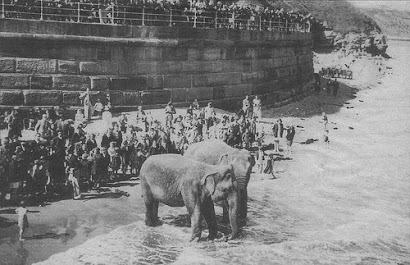



UNDERGROUND WHITBY






In Whitby, upon the Eve of All Saints, it was customary for young suitors to practice strange divinations. The medium for one peculiar process of love prognostication was the nut. Couples would throw two hazelnuts into the fire. If they burned quietly together, then a harmonious marriage lay ahead. Exploding, popping nuts that ricochet around the room upon all hallows eve were considered an inauspicious omen.


The spells were in vain, the hag returned
To the green in sorrowful mood
Crying that witches have no power,
Where there is a rowan-tree wood.
From The Old Ballad of Laidley Wood
From the secluded back lanes and woods of the English countryside to the cities' municipal parks, the European Rowan Tree (Sorbus aucuparia) is a common sight throughout the British Isles. In fact it is such a familiar part of the landscape that it almost becomes inconspicuous, when compared to it’s grander cousins like the English Oak and the Sycamore. But the truth is that the humble Rowan tree has a remarkable story to tell.

The tree itself is referred to in numerous mythologies throughout history, the ancient Greeks believed the tree was created from the blood and feathers of an eagle sent to aid Hebe in her battle to regain the chalice of ambrosia. The Rowan that appears in Celtic mythology is often associated with druidic rituals, where as the Norse myths relate to the Rowan as been the creator of woman. The tree also constantly recurs in literature from the ancient sagas and poems of the Irish right through to contemporary stories like J R R Tolkien’s Lord Of The Rings.
During the 16th century the emergence of a more puritanical Christian church forced the last residual enclaves of paganism to the periphery of society, where anyone that was deemed a follower of the old order was branded a practitioner of witchcraft and subjected to trails, torture and invariably executions. This meant that thousands of innocent people across the whole of Europe were put to death, simply because they put their faith in nature and an ancient knowledge that had been passed down through the generations.
What is testament to the iconic power of the Rowan tree that it was able to survive these events, but it was with a certain amount of irony that the defining symbol of paganism had to suffer the indignity of been turned into the very object that was need to protect a person from the supposed malevolent forces of magic. It seemed on an intuitive level there was still an awareness of the tree’s importance, but the old, true meaning had become distorted through this new indoctrination of the people.

The following extract is taken from ‘Forty Years In A Moorland Parish’ written by the Reverend Canon Atkinson in 1891, and is an account of the ritualised preparation and use of the Rowan as a charm against witchcraft.
To be effectual, the requisite piece of rowan tree,- for many were wanted; one for the upper sill of the house door, one for the corresponding position as to stable, cow byre and the other domiciles of the various stock, one for personal use, one for the head of the bed, one for the house place etc, etc, - must not only be cut on St. Helen’s day, but, in order to be quite fully efficacious, they must be cut with a household knife: they must be cut, moreover, from a tree which not only the cutter had never seen before, but of the very existence of which she must have no previous knowledge or suspicion; and that, on the tree having been found in this blindfold sort of way, and the requisite bough or boughs having been severed and secured, they must be carried home by any way save that by which the obtainer of them had gone forth on his quest.
It would appear that the remoteness of the surrounding moorland had a significant influence on these archaic rituals enduring far into 19th century. In places like Danby, Lealholm and Castleton the people still considered witches and witchcraft to be such a serious threat to their homes and livestock that ‘Witch Wood‘ was considered to be the only effective means of keeping these malign creatures at bay. In fact so prolific were these enchantresses that many of the villagers could name and identify them as well as where they were perceived to live.
BY RICHARD LOCKER

 Ruswarp Hall
Ruswarp Hall
 |
| Brown Bushell in Scarborough Art Gallery |
 In 1916 two dismembered paintings were found in the box room at Bagdale Old Hall. They were duly sent to London for restoration and returned to the hall in something akin to their former glory. They were portraits made directly onto wooden panels, probably by some unknown itinerant italian artist. One was of Browne Bushell aged 24, the other depicted Dorothy, his bride aged 19. They were dated 1633. Each sitter is wearing a betrothal ring on a chain round their necks.........................
In 1916 two dismembered paintings were found in the box room at Bagdale Old Hall. They were duly sent to London for restoration and returned to the hall in something akin to their former glory. They were portraits made directly onto wooden panels, probably by some unknown itinerant italian artist. One was of Browne Bushell aged 24, the other depicted Dorothy, his bride aged 19. They were dated 1633. Each sitter is wearing a betrothal ring on a chain round their necks.........................



 Witch posts: 1 From Danby. 2 From an old house near Scarborough. 3 Postgate Farm, Glaisdale. 4. In Stang End at the Rydale Folk Museum. 5 Low Bell End, Rosedale. 6 Gillamoor. 7 Quarry Farm, Glaisdale.
Witch posts: 1 From Danby. 2 From an old house near Scarborough. 3 Postgate Farm, Glaisdale. 4. In Stang End at the Rydale Folk Museum. 5 Low Bell End, Rosedale. 6 Gillamoor. 7 Quarry Farm, Glaisdale.
